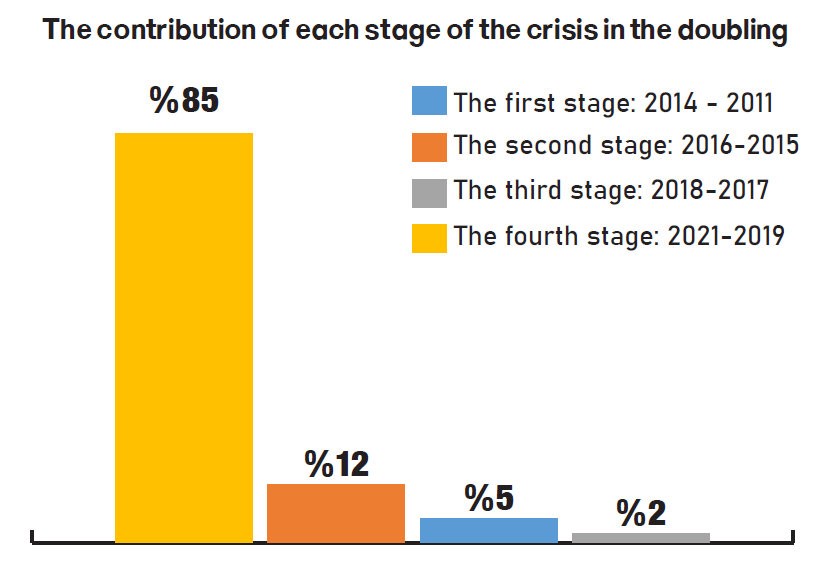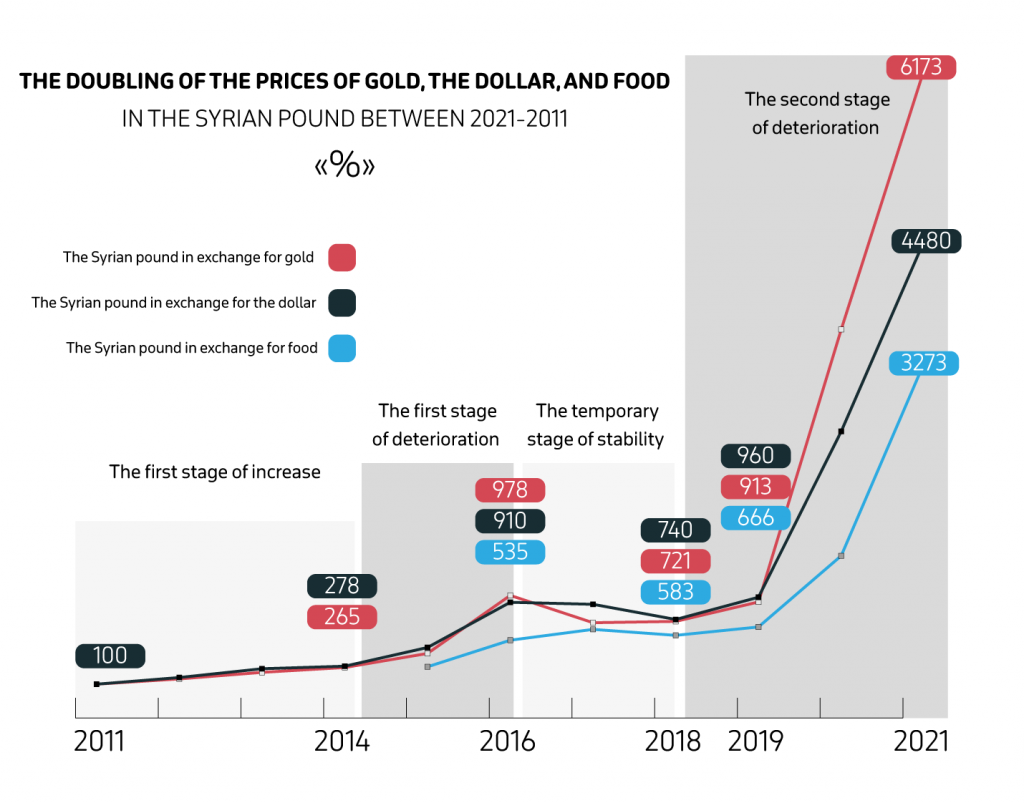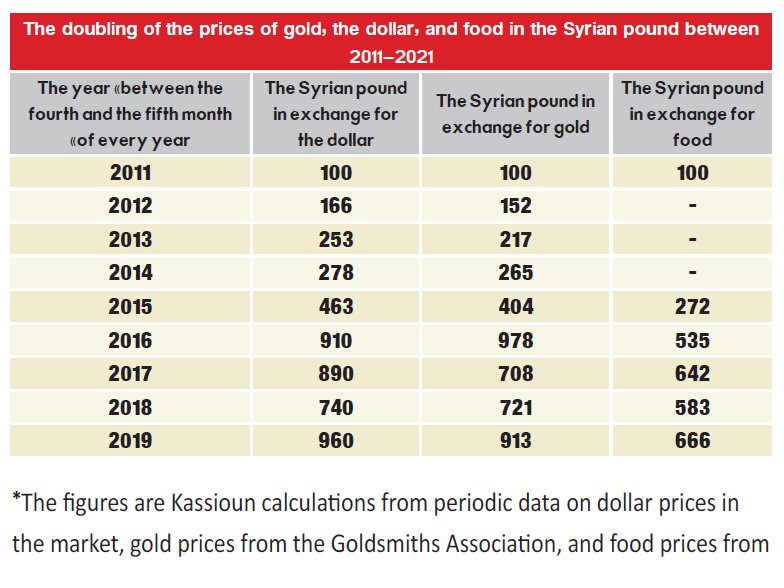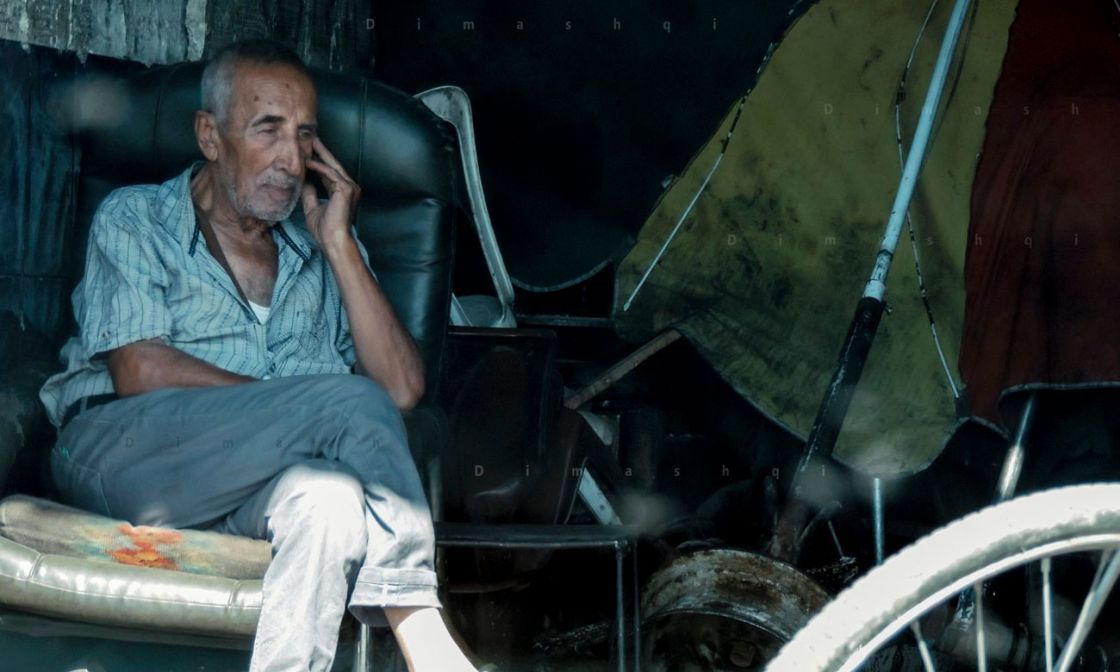- Articles
- Posted
Gold, the Dollar, and Food; along Ten Years between Foreign Policy and Internal Policies.
Ten years and our crisis is still ongoing, and the deterioration of the value of the Syrian pound that we see in the increase of the level of prices is its most prominent economic epitome, as it reflects the overall economic, social and political deterioration as well. This insane high rocketing in prices means that poverty is practically reaching more than 85% of Syrians, and also hunger reaching nearly two-thirds of Syrians across the country. It is also an expression of mega-rich people's protection of their wealth through their commodities that preserve their value, most notably: the dollar and gold.
The graphs that reflects the level of the doubling of the prices of the dollar, gold, and the basic food basket can tell a lot about the economic and political stages of the Syrian crisis. It can also label the crisis in basic stages on the scale of acceleration and deceleration of deterioration. We chose gold because it is (the commodity of the rich) being a basic savings tool that is available in the Syrian market, and whose market has witnessed major leaps and fluctuations in the Syrian crisis. The dollar is also a means of savings, and even an investment tool for a segment of the rich during the years of the crisis, as investment in dollars is one of the main areas of profit, and its relation to foreign trade and the illegal market makes its market wide and its trades relatively numerous compared to gold. As for the monthly food basket which we take here from the calculations of Kassioun for the costs of living, it is practically the basket that expresses the capability of securing the basics, and the level of deterioration in the daily life of millions of Syrians. It is practically the commodity whose changes measure the situation of the lives of millions of poor people.
The Four Main Stages Between 2011 – 2021
The graphs and changes point out to four main stages during the last ten years:
2011 – 2014: the first stage of the increase in which the increase was annual and convergent, and which contributed to 5% on average of the total increase of prices during the ten years.
2015 - 2016: the first stage of deterioration in which the level of prices increased by rapid rates during a short period of time, and it contributed to 12% on average of the increase.
2017 – 2018: the stage of temporary stability which witnessed a relative decrease in prices and decreased deterioration by 2% on average.
2019 – 2021: the second more rapid deterioration stage: which contributed until now to 85% on average of the increase in prices during the ten years.
During each of these stages, there are important political turning points that determine deterioration and improvement, and they are clearly connected to economic variables and to policies as well.

Politics and their Effect on the Division of the Country
In the first stage: between 2011 – 2014. The area of the battles inside the country was expanding until the armed phenomena spread to all areas of tension, and the year 2013 was the most severe in the increase at that time. The crisis has moved to a level of full armament, where regions and cities were relatively dismembered from Syria, and many Syrian rural areas have witnessed wide destruction. This stage also witnessed sanctions on Syrian oil and the suspension of Western companies working there. As for the next stage: between 2015 – 2016, it was the first stage of economic deterioration, as it witnessed the consolidation of the terrorist (ISIS) phenomenon and the complete separation associated with it between the east of the country and the center through the dominance of the terrorist organization over al-Raqqa and over large parts of Badia, in addition to the loss of gas and oil fields associated with this and the reduction in the ability of transportation and movement. Most importantly: this stage witnessed the highest rates of displacement and refuge from Syria, and the country have lost in this stage the largest number of its citizens which have become refugees.

From Armament and (ISIS) to Astana
The third stage: the only stage of stability between 2017 -2018. It is the stage in which a large decline for (ISIS) has started until it reached the ceasing of its influence. Most importantly, it witnessed the Astana agreements which generalized truce and calmness in many important regions. This has stopped battles to a large extent in wide areas in the south, in Damascus countryside, and in important parts of the countryside of Aleppo and Homs, which are all vital areas whether in agricultural or industrial production or in the general economic life of the country and the centralization of its man powers. They are also regions that are extended on the vital artery of Syria: the M5 highway, which is represented in the line of the middle region, particularly the region extending from Hama to the south, which is the main way that connects the north of the country with its south, and which despite its inclusion of Aleppo back then, it connected the middle region with the south again.

Sanctions and the Intractability of Connecting the Regions of the Country
The fourth stage: 2019 – 2021which extends until today. It is the second deterioration stage that has passed its third year. Practically, this stage has witnessed the highest deterioration rates within the shortest period of time. Politically, this stage is related to the intensification of economic sanctions, and the intractability in presenting solutions and political settlements on part of the Syrian extremist parties who are still not approving of the country moving to the minimum level of reconciliation, political convergence, and dialogue among its people. Those parties have also disapproved of an actual application of the declared agreements regarding opening the roads as part of Astana agreements. Generally, the intractability in benefiting from the opportunity of Astana to move to a politically better and more thorough level of settlements is the most important political factor of the deterioration of 2019 – 2021.
The dismemberment of the country is one of the most important factors that allow sanctions to be effective. This was relatively expected to reach the level it has reached today: the resurgence of tension to quiet areas, and the ceasing of the (limited) energy artery which has been flowing during the previous years from the south-eastern regions to the main cities in the country, particularly to refineries in Homs and Baniyas, and which have not completely ceased even during the period of the presence of (ISIS). However, it has ceased in 2020 and has not been retrieved until now! In addition, the Astana agreement in Idlib has not witnessed a progression, and the most important point in it within this context is the allowance of a complete traffic through the M4 highway between Aleppo and Hama, passing through the east of Idlib, and the part of the M4 highway that passes through Idlib and connect Aleppo to Lattakia. This intractability is a major factor that grounds on with sanctions for the continuation of the dismemberment of the country, the deterioration of the situations of Syrians in all regions, and working on consolidating the (de facto division).
The current level of deterioration will only end or relatively stabilize by politically moving into the next stage, at least to allow back the flow of energy, i.e.: reaching agreements between government and Autonomous Administration instead of the military escalation we’re living today. It will also only work by reaching new agreements with Turkey and the parties affected by de facto, at least to open the roads through Idlib and the eastern countryside of Aleppo. It also requires political agreements at the minimum to consolidate stability in the regions of the south, and to reach agreements that completely allow the reactivation of the southern part of the road all the way to Nassib Border Crossing, to stop the straining that allows (Israel) to get in and opens a door for it in the region of the south that can only be closed by strengthening reconciliation with the Syrian powers and the society there. The current tense atmosphere is a result of economic deterioration and political intractability, and it will push towards more political tension if a process of (economic reconciliation) did not occur at minimum levels. This can only happen through political agreements and the willingness of the Syrian political parties to open up to each other and to all the influential powers in the region, especially Turkey, which constitutes one of the knots being part of Astana, and a party that has a lot of leverage that effects the life of Syrians and their economy. However, what is more important is that more than 3 million Syrians live there.
Internal Economic Policies and their (Toxic Effect)
Amongst all these foreign determinants that play a crucial role in effecting the total economic situation, thus, on the value of the Syrian pound and the price of the dollar, gold, and food costs, internal economic policies are not less important, but rather highly important in the economic stream.
In the first stage between 2011 – 2014, economic parties did not take any precautionary procedure in anticipation of the possible deterioration. On the contrary, they took economic decisions that increase the fragility of the state apparatus and its ability to control the (sovereign economic determinants) such as the value of the Syria pound. Those decisions gave clear indications for an accelerated increase in the weights of major market powers related to the powers of influence and corruption. Practically, policies have dealt with the exchange rate during this stage with an excessively careless management, and they were chasing the market during those four years, selling foreign exchange to the market periodically. Until 2015, the estimations of the World Bank (which are the only estimations available) had said that the Syrian reserves of hard currencies had fallen to nearly 700 million dollars, while they used to be close to 17 billion dollars! There were widespread rumors from regional media about the sale of gold reserves that were not denied by the government and no official statements were issued proving the contrary. Thus, the policy of ambiguity and not declaring the size of the remaining reserves has begun.
What is clear and certain is that the central bank used to transfer the dollar to the market periodically, through financing the imports of merchants selectively with the official dollar price throughout all this stage. This led to the transfer of a significant part of the Syrian reserve to major importers who monopolize the trade of the basics, and who obtained cheap dollar, while its price in the market was higher. This process was not less than 4-5 billion dollars annually, in addition to direct intervention processes to sell foreign exchange through exchange companies and offices with every speculation wave from the market. This was also accompanied by the decline in government budget and an extensive austerity policy. As the budget figure declined compared to the dollar by approximately 50% between 2011-2014, that is: the government has reduced its investment and development presence by half, and this reduction may be much more as the government does not declare its actual expenditure! At the end of 2014, authorities have declared that they will privatize the cellular telecommunication sector. So, instead of regaining their full management and ownership of the sector as stipulated in the contract, they practically changed the contract in favor of investors, and gave up on extensive financial resources in favor of investors (whose corruption and mismanagement were discovered after 6 years!) this process was the most prominent indicator of the economic policy during the crisis; a neo-liberal policy that marginalizes the state apparatus and its economic and developmental role during the war, and transfers the control in the market to major powers that use the state apparatus in their influence and corruption.

The Stage of Attack on Society
The second stage between 2015-2016. The most prominent epitome of economic policies was increasing the prices of the basics. In this stage, authorities have inaugurated shock therapy policies, as they increased in one decision the prices of diesel oil, LPG, bread, and fuel at rates amongst which the lowest were 30% and the highest 70%. That was on Jan 17, 2015, and it was followed by the decision of increasing the prices of fodder within less than a month, to announce the start of a marathon of price increase that has reached all basic materials. This process continued in the first half of 2016, as during the first six months of 2016, speculation waves on the dollar were frequent and huge, and exchange rates have increased from 390 Syrian pounds to reach the peak of 620 Syrian pounds, only to return to decline later. What did the government do during those speculation waves? It increased the prices of all basic materials again: electricity in the beginning of 2016, where average sales per kilowatt have increased by 950%, fuel by 37%, and telecommunications by 55%. During this stage of rapid deterioration, the government led the economy towards the deterioration of the Syrian pound. Speculation and pumping dollars to the market continued, and the prices of the basics increased including energy, bread, main services, giving the spark and the indication to increasing the prices and reducing the value of the Syrian pound.
All this was while the government was obtaining oil periodically through the Iranian credit line, in this stage!
During Stability; Selling (Everything that can be Sold)
The stage of stability between 2017-2018. During this stage, the only positive thing the government did was that it stopped direct selling of the dollar to the market and fixed its official price. The main mechanism was limiting the movement of the Syrian pound in banks despite the announcement of opening the door to lending which has not practically opened. In return, the processes of financing imports continued with relative narrowing to them. Government policies did not contribute to the stage of stability, rather the regional and international circumstance and the desire of many Syrian investors inside the country to capture the investment opportunity provided by the stability of a devastated country or the features of reconstruction.
The main negative contribution of policies in this stage was by signing and establishing notorious investment contracts, which served as a wave of (selling the effective resources of the state apparatus): phosphate, with a share less than 30% to the government versus 70% to partners, investing of fertilizer plants with the same rate, and finally crystallizing the contract of the port in this stage, the investment which nobody knows its outcome or feasibility yet. During the stability stage in exchange rate, economic policies of influential powers concentrated on showing (any kind of reconstruction they want), and it was found that the model of the (Lebanese Hariri) is still shinning among them. As we witnessed during those two years a series of decrees and laws related to (reconstruction) which focused on real estate investment, resulting with the (fake project) of Marota City, the most important results of which were the (displacement) of the people of the region behind al-Razi in Damascus, and finding a temporary interface for laundering the money of new billionaires. The (new faces) of war profiteers have roamed on the surface of this stage, those who bought the largest Syrian-Gulf hotels and became obvious partners in every major industry from car assembly to iron, mills, and medicine, reaching real estate, media investment and others, of course.
The Stage of Deterioration; Preoccupation in (Fundraising)
The second stage of deterioration from 2019-2021. Policies have become edgy and reflected the crisis of elites and dealing moment by moment with facts. The most prominent epitome is: the approximate ceasing of energy supplies and including major influential powers to the circle of investing the basics, and the transformation of the monopoly of basic commodities into an important profit field. Food prices started leaping at exceptional rates, higher than the prices of the international market, by rates that exceed 40% and more. Practically, during this stage, the energy market has been liberalized to a large extent, and the amounts of stolen liberalized fuel from the state apparatus that were sold in the market were larger than the officially distributed amount, which have dwindled to a large extent, as the flow of heating-oil have reduced, and the production of electric energy have declined. A profit method was used for the (partners of electronic cards) with unannounced contracts, to gain from every spending on one liter of fuel, a jar of LPG, and finally a bundle of bread as the government is marketing, so distributed quantities would, in return, be restricted at reduced prices.
The sources of money flow to the major powers of the market have declined, and disputes between powers of influence have started, which resulted in major disturbances in the foreign exchange and gold markets and the extensive smuggling of money abroad. Practically, those disputes only reflect a new major centralization process, by the removal of some powers and the leadership of others, with all that results from this of wealth centralization. There are three distinguishing marks in the policies of this stage, the first one: leaving the state apparatus, the Syrian pound, and food prices to their fate, the second one: concentrating on conflict management between major powers and centralizing wealth and profit from the basics of food and energy, waiting for (regional and international relief). Whereas the third one is an unprecedented expansion of the crime market inside Syria, the level of which has been shown by the confiscations of Captagon leaving Syrian ports or the confiscations on the southern borders. This is the frightening phenomenon that expresses the size and weight of criminal powers inside the country, amidst complete silence and neglect on part of the parties that reiterate their concern for (Syrian sovereignty).



 Ashtar Mahmood
Ashtar Mahmood